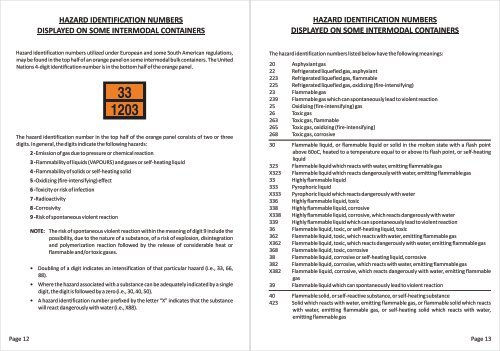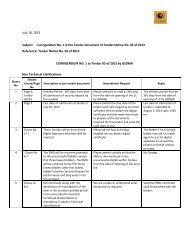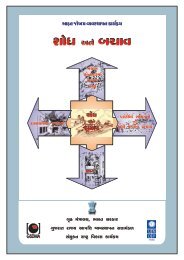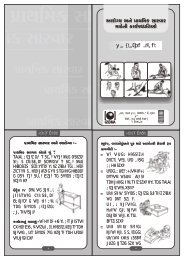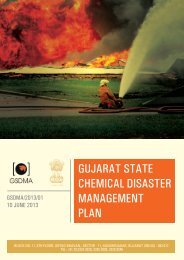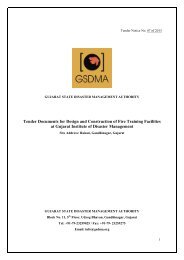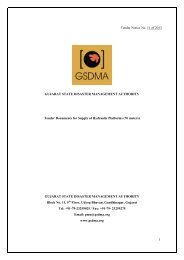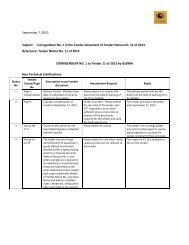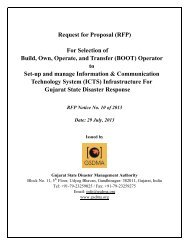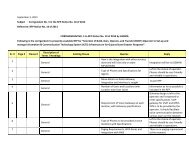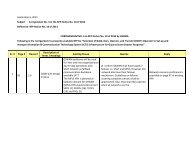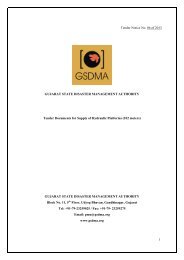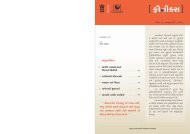HAZARD IDENTIFICATION NUMBERSDISPLAYED ON SOME INTERMODAL CONTAINERSHAZARD IDENTIFICATION NUMBERSDISPLAYED ON SOME INTERMODAL CONTAINERSHazard identification numbers utilized under European and some South American regulations,may be found in the top half of an orange panel on some intermodal bulk containers. The UnitedNations 4-digit identification number is in the bottom half of the orange panel.The hazard identification number in the top half of the orange panel consists of two or threedigits. In general, the digits indicate the following hazards:2 -Emission of gas due to pressure or chemical reaction3 -Flammability of liquids (VAPOURS) and gases or self-heating liquid4 -Flammability of solids or self-heating solid5 -Oxidizing (fire-intensifying) effect6 -Toxicity or risk of infection7 -Radioactivity8 -Corrosivity9 -Risk of spontaneous violent reaction331203NOTE: The risk of spontaneous violent reaction within the meaning of digit 9 include thepossibility, due to the nature of a substance, of a risk of explosion, disintegrationand polymerization reaction followed by the release of considerable heat orflammable and/or toxic gases.• Doubling of a digit indicates an intensification of that particular hazard (i.e., 33, 66,88).• Where the hazard associated with a substance can be adequately indicated by a singledigit, the digit is followed by a zero (i.e., 30, 40, 50).• A hazard identification number prefixed by the letter “X” indicates that the substancewill react dangerously with water (i.e., X88).The hazard identification numbers listed below have the following meanings:20 Asphyxiant gas22 Refrigerated liquefied gas, asphyxiant223 Refrigerated liquefied gas, flammable225 Refrigerated liquefied gas, oxidizing (fire-intensifying)23 Flammable gas239 Flammable gas which can spontaneously lead to violent reaction25 Oxidizing (fire-intensifying) gas26 Toxic gas263 Toxic gas, flammable265 Toxic gas, oxidizing (fire-intensifying)268 Toxic gas, corrosive30 Flammable liquid, or flammable liquid or solid in the molten state with a flash pointabove 60oC, heated to a temperature equal to or above its flash point, or self-heatingliquid323 Flammable liquid which reacts with water, emitting flammable gasX323 Flammable liquid which reacts dangerously with water, emitting flammable gas33 Highly flammable liquid333 Pyrophoric liquidX333 Pyrophoric liquid which reacts dangerously with water336 Highly flammable liquid, toxic338 Highly flammable liquid, corrosiveX338 Highly flammable liquid, corrosive, which reacts dangerously with water339 Highly flammable liquid which can spontaneously lead to violent reaction36 Flammable liquid, toxic, or self-heating liquid, toxic362 Flammable liquid, toxic, which reacts with water, emitting flammable gasX362 Flammable liquid, toxic, which reacts dangerously with water, emitting flammable gas368 Flammable liquid, toxic, corrosive38 Flammable liquid, corrosive or self-heating liquid, corrosive382 Flammable liquid, corrosive, which reacts with water, emitting flammable gasX382 Flammable liquid, corrosive, which reacts dangerously with water, emitting flammablegas39 Flammable liquid which can spontaneously lead to violent reaction40 Flammable solid, or self-reactive substance, or self-heating substance423 Solid which reacts with water, emitting flammable gas, or flammable solid which reactswith water, emitting flammable gas, or self-heating solid which reacts with water,emitting flammable gasPage 12Page 13
HAZARD IDENTIFICATION NUMBERSDISPLAYED ON SOME INTERMODAL CONTAINERSHAZARD IDENTIFICATION NUMBERSDISPLAYED ON SOME INTERMODAL CONTAINERSX423 Solid which reacts dangerously with water, emitting flammable gas, or flammablesolid which reacts dangerously with water, emitting flammable gas, or self-heatingsolid which reacts dangerously with water, emitting flammable gas43 Spontaneously flammable (pyrophoric) solidX432Spontaneously flammable (pyrophoric) solid which reacts dangerously with water,emitting flammable gas44 Flammable solid, in the molten state at an elevated temperature446 Flammable solid, toxic, in the molten state at an elevated temperature46 Flammable solid, toxic, or self-heating solid, toxic462 Toxic solid which reacts with water, emitting flammable gasX462 Solid which reacts dangerously with water, emitting toxic gas48 Flammable or self-heating solid, corrosive482 Corrosive solid which reacts with water, emitting flammable gasX482 Solid which reacts dangerously with water, emitting corrosive gas50 Oxidizing (fire-intensifying) substance539 Flammable organic peroxide55 Strongly oxidizing (fire-intensifying) substance556 Strongly oxidizing (fire-intensifying) substance, toxic558 Strongly oxidizing (fire-intensifying) substance, corrosive559 Strongly oxidizing (fire-intensifying) substance which can spontaneously lead toviolent reaction56 Oxidizing (fire-intensifying) substance, toxic568 Oxidizing (fire-intensifying) substance, toxic, corrosive58 Oxidizing (fire-intensifying) substance, corrosive59 Oxidizing (fire intensifying) substance which can spontaneously lead to violentreaction60 Toxic substa.nce606 Infectious substance623 Toxic liquid which reacts with water, emitting flammable gas63 Toxic substance, flammable638 Toxic substance, flammable, corrosive639 Toxic substance, flammable, which can spontaneously lead to violent reaction64 Toxic solid, flammable or self-heating642 Toxic solid which reacts with water, emitting flammable gas65 Toxic substance, oxidizing (fire-intensifying)66 Highly toxic substance663 Highly toxic substance, flammable664 Highly toxic solid, flammable or self-heating665 Highly toxic substance, oxidizing (fire-intensifying)668 Highly toxic substance, corrosiveX668 Highly toxic substance, corrosive, which reacts dangerously with water669 Highly toxic substance which can spontaneously lead to violent reaction68 Toxic substance, corrosive69 Toxic substance which can spontaneously lead to violent reaction70 Radioactive material78 Radioactive material, corrosive80 Corrosive substanceX80 Corrosive substance which reacts dangerously with water823 Corrosive liquid which reacts with water, emitting flammable gas83 Corrosive substance, flammableX83 Corrosive substance, flammable, which reacts dangerously with water839 Corrosive substance, flammable, which can spontaneously lead to violent reactionX839 Corrosive substance, flammable, which can spontaneously lead to violent reaction andwhich reacts dangerously with water84 Corrosive solid, flammable or self-heating842 Corrosive solid which reacts with water, emitting flammable gas85 Corrosive substance, oxidizing (fire-intensifying)856 Corrosive substance, oxidizing (fire-intensifying) and toxic86 Corrosive substance, toxic88 Highly corrosive substanceX88 Highly corrosive substance which reacts dangerously with water883 Highly corrosive substance, flammable884 Highly corrosive solid, flammable or self-heating885 Highly corrosive substance, oxidizing (fire-intensifying)886 Highly corrosive substance, toxicX886 Highly corrosive substance, toxic, which reacts dangerously with water89 Corrosive substance which can spontaneously lead to violent reaction90 Miscellaneous dangerous substance; environmentally hazardous substance99 Miscellaneous dangerous substance transported at an elevated temperaturePage 14Page 15
- Page 2 and 3: SHIPPING DOCUMENTS (PAPERS)Shipping
- Page 4 and 5: HAZARD CLASSIFICATION SYSTEMThe haz
- Page 6 and 7: EMERGENCY INFORMATION PANEL800In In
- Page 10 and 11: PIPELINE TRANSPORTATIONIn Gujarat,
- Page 12 and 13: • If flames present, driving away
- Page 14 and 15: ID Guid Name of Material ID Guid Na
- Page 16 and 17: ID Guid Name of Material ID Guid Na
- Page 18 and 19: ID Guid Name of Material ID Guid Na
- Page 20 and 21: ID Guid Name of Material ID Guid Na
- Page 22 and 23: ID Guid Name of Material ID Guid Na
- Page 24 and 25: ID Guid Name of Material ID Guid Na
- Page 26 and 27: ID Guid Name of Material ID Guid Na
- Page 28 and 29: ID Guid Name of Material ID Guid Na
- Page 30 and 31: ID Guid Name of Material ID Guid Na
- Page 32 and 33: ID Guid Name of Material ID Guid Na
- Page 34 and 35: ID Guid Name of Material ID Guid Na
- Page 36 and 37: ID Guid Name of Material ID Guid Na
- Page 38 and 39: ID Guid Name of Material ID Guid Na
- Page 40 and 41: ID Guid Name of Material ID Guid Na
- Page 42 and 43: ID Guid Name of Material ID Guid Na
- Page 44 and 45: ID Guid Name of Material ID Guid Na
- Page 46 and 47: ID Guid Name of Material ID Guid Na
- Page 48 and 49: Name of Material Guid ID Name of Ma
- Page 50 and 51: Name of Material Guid ID Name of Ma
- Page 52 and 53: Name of Material Guid ID Name of Ma
- Page 54 and 55: Name of Material Guid ID Name of Ma
- Page 56 and 57: Name of Material Guid ID Name of Ma
- Page 58 and 59:
Name of Material Guid ID Name of Ma
- Page 60 and 61:
Name of Material Guid ID Name of Ma
- Page 62 and 63:
Name of Material Guid ID Name of Ma
- Page 64 and 65:
Name of Material Guid ID Name of Ma
- Page 66 and 67:
Name of Material Guid ID Name of Ma
- Page 68 and 69:
Name of Material Guid ID Name of Ma
- Page 70 and 71:
Name of Material Guid ID Name of Ma
- Page 72 and 73:
Name of Material Guid ID Name of Ma
- Page 74 and 75:
Name of Material Guid ID Name of Ma
- Page 76 and 77:
Name of Material Guid ID Name of Ma
- Page 78 and 79:
Name of Material Guid ID Name of Ma
- Page 80 and 81:
Name of Material Guid ID Name of Ma
- Page 82 and 83:
GUIDE INDEXGuide No. Type of Substa
- Page 84 and 85:
GUIDE112Explosives* - Division 1.1,
- Page 86 and 87:
GUIDE114Explosives* - Division 1.4
- Page 88 and 89:
GUIDE116Gases - Flammable (Unstable
- Page 90 and 91:
GUIDE118Gases - Flammable - Corrosi
- Page 92 and 93:
GUIDE120Gases - Inert(Including Ref
- Page 94 and 95:
GUIDE122Gases - Oxidizing(Including
- Page 96 and 97:
GUIDE124Gases - Toxic and/or Corros
- Page 98 and 99:
GUIDE126Gases - Compressed or Lique
- Page 100 and 101:
GUIDE128Flammable Liquids(Non-Polar
- Page 102 and 103:
GUIDE130Flammable Liquids(Non-Polar
- Page 104 and 105:
GUIDE132Flammable Liquids - Corrosi
- Page 106 and 107:
GUIDE134Flammable Solids - Toxic an
- Page 108 and 109:
GUIDE136Substances - Spontaneously
- Page 110 and 111:
GUIDE138Substances - Water - Reacti
- Page 112 and 113:
GUIDE140OxidizersERG2012ERG2012Oxid
- Page 114 and 115:
GUIDE142Oxidizers - Toxic (Liquid)E
- Page 116 and 117:
GUIDE144Oxidizers (Water-Reactive)E
- Page 118 and 119:
GUIDE146Organic Peroxides (Heat, Co
- Page 120 and 121:
GUIDE148Organic Peroxides (Heat and
- Page 122 and 123:
GUIDE150Substances (Self-Reactive/T
- Page 124 and 125:
GUIDE152Substances - Toxic (Combust
- Page 126 and 127:
GUIDE154Substances - Toxic and/or C
- Page 128 and 129:
GUIDE156Substances - Toxic and/or C
- Page 130 and 131:
GUIDE158Infectious SubstancesERG201
- Page 132 and 133:
GUIDE160Halogenated SolventsERG2012
- Page 134 and 135:
GUIDE162Radioactive Materials(Low t
- Page 136 and 137:
GUIDE164Radioactive Materials (Spec
- Page 138 and 139:
GUIDE166Radioactive Materials - Cor
- Page 140 and 141:
GUIDE168Carbon Monoxide (Refrigerat
- Page 142 and 143:
GUIDE170Metals (Powders, Dusts, Sha
- Page 144 and 145:
GUIDE172Gallium and MercuryERG2012E
- Page 146 and 147:
Materials which react with water to
- Page 148 and 149:
HOW TO USE TABLE 1 - INITIAL ISOLAT
- Page 150 and 151:
TABLE 1 - INITIAL ISOLATION AND PRO
- Page 152 and 153:
TABLE 1 - INITIAL ISOLATION AND PRO
- Page 154 and 155:
TABLE 1 - INITIAL ISOLATION AND PRO
- Page 156 and 157:
TABLE 1 - INITIAL ISOLATION AND PRO
- Page 158 and 159:
TABLE 1 - INITIAL ISOLATION AND PRO
- Page 160 and 161:
TABLE 1 - INITIAL ISOLATION AND PRO
- Page 162 and 163:
TABLE 1 - INITIAL ISOLATION AND PRO
- Page 164 and 165:
TABLE 1 - INITIAL ISOLATION AND PRO
- Page 166 and 167:
TABLE 1 - INITIAL ISOLATION AND PRO
- Page 168 and 169:
TABLE 1 - INITIAL ISOLATION AND PRO
- Page 170 and 171:
TABLE 1 - INITIAL ISOLATION AND PRO
- Page 172 and 173:
TABLE 1 - INITIAL ISOLATION AND PRO
- Page 174 and 175:
TABLE 1 - INITIAL ISOLATION AND PRO
- Page 176 and 177:
TABLE 2 - WATER-REACTIVE MATERIALS
- Page 178 and 179:
TABLE 2 - WATER-REACTIVE MATERIALS
- Page 180 and 181:
UN1005 Ammonia, anhydrous: Large Sp
- Page 182 and 183:
4-Green-bordered pages: This sectio
- Page 184 and 185:
Protective Suits (NFPA 1992 & 1993)
- Page 186 and 187:
BLEVE - SAFETY PRECAUTIONSUse with
- Page 188 and 189:
INDICATORS OF A POSSIBLE RADIOLOGIC
- Page 190 and 191:
GlossaryGlossaryAEGL(s)AEGL-1AEGL-2
- Page 192 and 193:
Flash pointGlossaryLowest temperatu
- Page 194 and 195:
ViscosityWarm zoneWater-sensitiveWa
- Page 196:
Emergency Response Telephone Number


